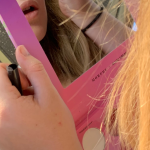On the third of July 2007, Transformers released in theatres. Attached to every screening like a parasite was an unlabelled trailer, comprised entirely of handheld footage. In it, people mill about at a going away party for a man named Rob. They drink and dance until the party is interrupted by a powerful roar that causes the lights to falter. After seeing a distant part of New York explode, the partygoers run out to the street, where they see the head of the Statue of Liberty flung down next to them. The trailer cuts to black, and one name appears on screen: J.J. Abrams.
MySpace pages for the major characters of the film were quickly found, as well as various websites for the movie and fictional companies within its narrative. The whole ordeal was an exercise in unfiction, also known as alternate reality games. A similar game had been created around Abrams’ TV series, Lost, which included the publication of a novel written by an in-universe author.
On the third of July, Cloverfield arrived in theatres.

Cloverfield is a western homage to the classic Japanese Kaiju genre, shot entirely in a found footage style similar to The Blair Witch Project. The film is directed by Matt Reeves and produced by J.J. Abrams through his production company, Bad Robot. It follows Rob and a group of friends as they try to survive together in the ruins of New York, caught between an enormous monster (known colloquially as Clover) and the U.S. Military, which intends to raze Manhattan in an attempt to kill the rampaging beast.
Cloverfield is a fine movie, never treading original ground but still making footprints on it. It represents the zenith of Abrams’ creative credibility, before Lost ended to little affection, and before his attachment to major franchises like Star Trek and Star Wars, each of which elevated and subsequently destroyed his public image.
Cloverfield’s sequels, therefore, can show us the decline of one of Hollywood’s most acclaimed minds, and along with that, the decline of the industry itself.
In the aftermath of Cloverfield, there was already talk of a direct sequel. Reeves entered talks with Paramount Pictures to direct a sequel as early as January 2008, the same month Cloverfield released. Abrams, however, showed less enthusiasm. He referred to the thought of a sequel as “kind of cool”, and by 2010 he started to consider abandoning the franchise’s signature found footage style.
In 2012, a spec script titled The Cellar was purchased by Paramount and given to Bad Robot for development. The filmmakers retooled The Cellar into what they called a “blood relative” to Cloverfield, not a literal sequel. The film has so little in common with Cloverfield that Mary Elizabeth Winstead and John Gallagher Jr., the film’s main cast, were not aware of the connection between the two films until days before the first trailer’s release, when the title was revealed to them: 10 Cloverfield Lane.
“Those characters and that monster are not in this movie, but there are other characters and other monsters,” said Abrams of the film, accidentally highlighting the absurdity of a franchise with few, if any, connections to itself.
Also in 2012, a film titled The God Particle was announced, also set to be produced by Bad Robot. Similarly to 10 Cloverfield Lane, the film originated from a spec script, and was retooled during production into The Cloverfield Paradox. According to Abrams himself in a post-release Facebook Live Q&A, the film had already started shooting before he figured out how it fitted into his franchise.
The final shot of the film shows a larger version of Clover, from the original film, roaring above the clouds, in a cheap attempt to connect the events of the two films together. At this juncture, the films were less blood relatives than shaky acquaintances: both sequels were preceded by scaled down versions of Cloverfield’s alternate reality game, and both films contain obscure references to even more obscure lore. At its core, the so-called ‘Cloververse’ is nothing more than a façade obscuring profit motives.
Another well-known film that originated from a spec script nearly fell victim to the same fate. A Quiet Place was pitched to Paramount by its writers as a potential Cloverfield film, but the company believed in its potential as a standalone project; perhaps, in part, due to the attachment of John Krasinski and Emily Blunt to the project.
“One of our biggest fears was this getting swept up into some kind of franchise or repurposed for something like that,” said A Quiet Place writer Bryan Woods. “It’s just that as filmgoers, we crave new and original ideas, and we feel like so much of what’s out there is IP.”
The Cloverfield franchise has become totemic of the rot within Hollywood; Intellectual Property has become a more valuable currency than original filmmaking. We have all watched as the once-creative space has been taken over by parasitic franchises like Marvel and Star Wars. The Cloververse has become a hammer with which to flatten original films that can’t stand on their own into a franchise; it’s a symbol of the death of creative filmmaking, in which mediocre ideas are bent to the shape of a recognisable name or logo. Writing for IndieWire, Michael Nordine said, “In the future, all movies will be Cloverfield movies”. In a sense, he may be right.
A true sequel to Cloverfield — whatever that means — is reported to be emerging from Abrams’ horrid womb in the near future. The nature of this film may tell us the very future of filmmaking itself: if a unique, original story is allowed to be born from the wreckage of this franchise, we may yet have hope. If it turns out to be a repurposed spec script, we’re all fucked.
Brock is an experimental fiction writer based in Meanjin. His writing writhes in the gaps between weird and weirder, with an emphasis on eutopianism. He can be found at @scholteyyy on Instagram or at brockscholte.com







